Heterogeneous Bimetallic Cu–Ni Nanoparticle-Supported Catalysts in the Selective Oxidation of Benzyl Alcohol to Benzaldehyde
Abstract
:1. Introduction
2. Results and Discussion
2.1. Catalyst Synthesis and Characterization
2.2. Benzyl Alcohol Oxidation Using Cu–Ni Bimetallic Catalysts
3. Materials and Methods
3.1. Materials
3.2. Preparation of Catalysts
3.3. Catalyst Characterization
3.4. Selective Oxidation of Benzyl Alcohol
4. Conclusions
Author Contributions
Funding
Conflicts of Interest
References
- Gong, X.; Liu, B.; Zhang, G.; Xu, G.; Zhao, T.; Shi, D.; Wang, Q.; Zhang, J. A mild and environmentally benign strategy towards hierarchical CeO2/Au nanoparticle assemblies with crystal facet-enhanced catalytic effects for benzyl alcohol aerobic oxidation. CrystEngComm 2016, 18, 5110–5120. [Google Scholar] [CrossRef]
- Harada, T.; Ikeda, S.; Hashimoto, F.; Sakata, T.; Ikeue, K.; Torimoto, T.; Matsumura, M. Catalytic activity and regeneration property of a Pd nanoparticle encapsulated in a hollow porous carbon sphere for aerobic alcohol oxidation. Langmuir 2010, 26, 17720–17725. [Google Scholar] [CrossRef] [PubMed]
- Možina, Š.; Stavber, S.; Iskra, J. Dual catalysis for the aerobic oxidation of benzyl alcohols-nitric acid and fluorinated alcohol. Eur. J. Org. Chem. 2017, 3, 448–452. [Google Scholar] [CrossRef]
- Sun, J.Y.; Han, Y.X.; Fu, H.Y.; Qu, X.L.; Xu, Z.Y.; Zheng, S.R. Au@Pd/TiO2 with atomically dispersed Pd as highly active catalyst for solvent-free aerobic oxidation of benzyl alcohol. Chem. Eng. J. 2017, 313, 1–9. [Google Scholar] [CrossRef]
- Tian, J.; Li, J.; Wei, N.; Xu, X.; Cui, H.; Liu, H. Ru nanoparticles decorated TiO2 nanobelts: A heterostructure towards enhanced photocatalytic activity and gas-phase selective oxidation of benzyl alcohol. Ceram. Int. 2016, 42, 1611–1617. [Google Scholar] [CrossRef]
- Meng, Y.Y.; An, Q.D.; Xiao, Z.Y.; Zhai, S.R.; Shi, Z. Pd NPs supported on N-doped carbon layer coated ZrSBA-15 for efficient heterogeneous catalysis reactions. Microporous Mesoporous Mater. 2018, 266, 64–74. [Google Scholar] [CrossRef]
- Sun, J.Y.; Tong, X.L.; Liu, Z.H.; Liao, S.Y.; Zhang, X.L.; Xue, S. Gold-catalyzed selectivity-switchable oxidation of benzyl alcohol in the presence of molecular oxygen. Catal. Commun. 2016, 85, 70–74. [Google Scholar] [CrossRef]
- Chen, L.J.; Yan, J.Q.; Tong, Z.X.; Yu, S.Y.; Tang, J.T.; Ou, B.L.; Yue, L.J.; Tian, L. Nanofiber-like mesoporous alumina supported palladium nanoparticles as a highly active catalyst for base-free oxidation of benzyl alcohol. Microporous Mesoporous Mater. 2018, 266, 126–131. [Google Scholar] [CrossRef]
- Alshammari, H.; Alhumaimess, M.; Alotaibi, M.H.; Alshammari, A.S. Catalytic activity of bimetallic AuPd alloys supported MgO and MnO2 nanostructures and their role in selective aerobic oxidation of alcohols. J. King Saud Univ. Sci. 2017, 29, 561–566. [Google Scholar] [CrossRef]
- Liu, L.L.; Zhou, X.J.; Yan, Y.M.; Zhou, J.; Zhang, W.P.; Tai, X.S. Bimetallic Gold-Silver Nanoparticles Supported on Zeolitic Imidazolate Framework-8 as Highly Active Heterogenous Catalysts for Selective Oxidation of Benzyl Alcohol into Benzaldehyde. Polymers 2018, 10, 1089. [Google Scholar] [CrossRef]
- Liu, L.L.; Tai, X.S.; Zhou, X.J.; Hou, J.X.; Zhang, Z.H. Bimetallic AueNi alloy nanoparticles in a metaleorganic framework (MIL-101) as efficient heterogeneous catalysts for selective oxidation of benzyl alcohol into benzaldehyde. J. Alloy. Compd. 2019, 790, 326–336. [Google Scholar] [CrossRef]
- Cruz, P.; Pérez, Y.; Hierro, I.D.; Fajardo, M. Copper, copper oxide nanoparticles and copper complexes supported on mesoporous SBA-15 as catalysts in the selective oxidation of benzyl alcohol in aqueous phase. Microporous Mesoporous Mater. 2016, 220, 136–147. [Google Scholar] [CrossRef]
- Fu, X.; Wu, S.; Li, Z.; Yang, X.; Wang, X.; Peng, L.; Hu, J.; Huo, Q.; Guan, J.; Kan, Q. Highly efficient Ni–Co oxide nanoparticles on nitrogen-doped FDU-15 for aerobic benzyl alcohol oxidation. RSC Adv. 2016, 6, 57507–57513. [Google Scholar] [CrossRef]
- Kimi, M.; Jaidie, M.M.H.; Pang, S.C. Bimetallic Cu–Ni nanoparticles supported on activated carbon for catalytic oxidation of benzyl alcohol. J. Phys. Chem. Solids 2018, 112, 50–53. [Google Scholar] [CrossRef]
- Chen, G.J.; Wang, J.S.; Jin, F.Z.; Liu, M.Y.; Zhao, C.W.; Li, Y.A.; Dong, Y.B. Pd@Cu(II)-MOF-catalyzed aerobic oxidation of benzylic alcohols in air with high conversion and selectivity. Inorg. Chem. 2016, 55, 3058–3064. [Google Scholar] [CrossRef]
- Kumar, A.; Gautam, R.K.; Belwal, M. Synthesis and characterization of Au/γ-Al2O3 nanocatalysts for vapor-phase selective oxidation of benzyl alcohol under aerobic condition. Curr. Catal. 2018, 7, 35–42. [Google Scholar] [CrossRef]
- Tareq, S.S.; Saiman, M.I.; Hin, T.Y.Y.; Abdullah, A.H.; Rashid, U. The impact of hydrogen peroxide as an oxidant for solvent-free liquid phase oxidation of benzyl alcohol using Au-Pd supported carbon and titanium catalysts. Bull. Chem. React. Eng. Catal. 2018, 13, 373–385. [Google Scholar] [CrossRef]
- Cordoba, M.; Miranda, C.; Lederhos, C.; Coloma-Pascual, F.; Ardila, A.; Fuentes, G.A.; Pouilloux, Y.; Ramírez, A. Catalytic performance of Co3O4 on different activated carbon supports in the benzyl alcohol oxidation. Catalysts 2017, 7, 384. [Google Scholar] [CrossRef]
- Liu, L.L.; Tai, X.S.; Zhou, X.J. Au3+/Au0 supported on chromium(III) terephthalate metal organic framework (MIL-101) as an efficient heterogeneous catalyst for three-component coupling synthesis of propargylamines. Materials 2017, 10, 89. [Google Scholar]
- Gil, S.; Garcia-Vargas, J.M.; Liotta, L.F.; Pantaleo, G.; Ousmane, M.; Retailleau, L.; Giroir-Fendler, A. Catalytic oxidation of propene over Pd catalysts supported on CeO2, TiO2, Al2O3 and M/Al2O3 oxides (M = Ce, Ti, Fe, Mn). Catalysts 2015, 5, 671–689. [Google Scholar] [CrossRef]
- Watanabe, M.; Aizawa, Y.; Iida, T.; Nishimura, R.; Inomata, H. Catalytic glucose and fructose conversions with TiO2 and ZrO2 in water at 473 K: Relationship between reactivity and acid–base property determined by TPD measurement. Appl. Catal. A Gen. 2005, 295, 150–156. [Google Scholar] [CrossRef]
- Liu, L.; Tai, X.; Liu, J.; Li, D.; Zhou, X.; Zhang, L.; Wei, X. Preparation of propargylamines catalyzed by heterogeneous catalysts with double catalytic sites. Chem. J. Chin. Univ.-Chin. 2018, 39, 482–490. [Google Scholar]
- Sun, Y.; Zhang, G.; Liu, J.; Zhao, P.; Hou, P.; Xu, Y.; Zhang, R. Effect of different activated carbon support on CH4–CO2 reforming over Co-based catalysts. Int. J. Hydrog. Energy 2018, 43, 1497–1507. [Google Scholar] [CrossRef]
- Harisekhar, M.; Pavan Kumar, V.; Shanthi Priya, S.; Chary, K.V.R. Vapour phase hydrogenolysis of glycerol to propanediols over Cu/SBA-15 catalysts. J. Chem. Technol. Biotechnol. 2015, 90, 1906–1917. [Google Scholar] [CrossRef]
- Jiang, H.; Wang, Q.; Wang, H.; Chen, Y.; Zhang, M. MOF-74 as an efficient catalyst for the low-temperature selective catalytic reduction of NOx with NH3. ACS Appl. Mater. Interfaces 2016, 8, 26817–26826. [Google Scholar] [CrossRef]
- Qiu, J.H.; Zhang, X.G.; Xie, K.L.; Zhang, X.F.; Feng, Y.; Jia, M.M.; Yao, J.F. Noble metal nanoparticle-functionalized Zr-metal organic frameworks with excellent photocatalytic performance. J. Colloid Interface Sci. 2019, 538, 569–577. [Google Scholar] [CrossRef] [PubMed]
- Chen, D.; Yang, D.; Dougherty, C.A.; Lu, W.; Wu, H.; He, X.; Cai, T.; Van Dort, M.E.; Ross, B.D.; Hong, H. In vivo targeting and positron emission tomography imaging of tumor with intrinsically radioactive metal-organic frameworks nanomaterials. ACS Nano 2017, 11, 4315–4327. [Google Scholar] [CrossRef] [PubMed]
- Akel, S.; Dillert, R.; Balayeva, N.O.; Boughaled, R.; Koch, J.; Azzouzi, M.E.; Bahnemann, D.W. Ag/Ag2O as a Co-catalyst in TiO2 photocatalysis: Effect of the Co-catalyst/photocatalyst mass ratio. Catalysts 2018, 8, 647. [Google Scholar] [CrossRef]
- Salmasi, M.; Fatemi, S.; Mortazavi, Y. Fabrication of promoted TiO2 nanotubes with superior catalytic activity against TiO2 nanoparticles as the catalyst of oxi-desulfurization process. J. Ind. Eng. Chem. 2016, 39, 66–76. [Google Scholar] [CrossRef]
- Chen, J.; Zhang, J.; Jiang, Y.; Yang, L.; Zhong, J.; Wang, G.; Wang, R. Enhanced formic acid electro-oxidation reaction on ternary Pd-Ir-Cu/C catalyst. Appl. Surf. Sci. 2015, 357, 994–999. [Google Scholar] [CrossRef]
- Kang, W.D.; Wei, Y.C.; Liu, C.W.; Wang, K.W. Enhancement of electrochemical properties on Pd–Cu/C electrocatalysts toward ethanol oxidation by atmosphere induced surface and structural alteration. Electrochem. Commun. 2011, 13, 162–165. [Google Scholar] [CrossRef]
- Nam, K.M.; Park, H.K.; Lee, C. Synthesis and electrochemical properties of carbon nanofibers and SiO2/carbon nanofiber composite on Ni–Cu/C-fiber textiles. J. Nanosci. Nanotechnol. 2015, 15, 8989–8995. [Google Scholar] [CrossRef] [PubMed]
- Karaca, H.; Safonova, O.V.; Chambrey, S.; Fongarland, P.; Roussel, P.; Constant, A.G.; Lacroix, M.; Khodakov, A.Y. Structure and catalytic performance of Pt-promoted alumina-supported cobalt catalysts under realistic conditions of Fischer–Tropsch synthesis. J. Catal. 2011, 277, 14–26. [Google Scholar] [CrossRef]
- Pieta, I.S.; Rathi, A.; Pieta, P.; Nowakowski, R.; Hołdynski, M.; Pisarek, M.; Kaminska, A.; Gawande, M.B.; Zboril, R. Electrocatalytic methanol oxidation over Cu, Ni and bimetallic Cu-Ni nanoparticles supported on graphitic carbon nitride. Appl. Catal. B Environ. 2019, 244, 272–283. [Google Scholar] [CrossRef]
- Duan, H.; Li, Y.; Lv, X.; Chen, D.; Long, M.; Wen, L. CuO–ZnO anchored on APS modified activated carbon as an enhanced catalyst for methanol synthesis-the role of ZnO. J. Mater. Res. 2018, 33, 1–7. [Google Scholar] [CrossRef]
- Sun, B.; Li, H.; Li, X.; Liu, X.; Zhang, C.; Xu, H.; Zhao, X.S. Degradation of organic dyes over fenton-like Cu2O–Cu/C catalysts. Ind. Eng. Chem. Res. 2018, 57, 14011–14021. [Google Scholar] [CrossRef]
- De Godoi, F.C.; Rodriguez-Castellon, E.; Guibal, E.; Beppu, M.M. An XPS study of chromate and vanadate sorption mechanism by chitosan membrane containing copper nanoparticles. Chem. Eng. J. 2013, 234, 423–429. [Google Scholar] [CrossRef]
- Liu, L.J.; Lou, H.; Chen, M. Selective hydrogenation of furfural to tetrahydrofurfuryl alcohol over Ni/CNTs and bimetallic CuNi/CNTs catalysts. Int. J. Hydrog. Energy 2016, 41, 14721–14731. [Google Scholar] [CrossRef]
- Liu, G.Q.; Zhang, X.; Zhao, C.J.; Xiong, Q.Z.; Gong, W.B.; Wang, G.Z.; Zhang, Y.X.; Zhan, H.M.; Zhao, H.J. Electrocatalytic oxidation of benzyl alcohol for simultaneously promoting H2 evolution by a Co0.83Ni0.17/activated carbon electro-catalyst. New J. Chem. 2018, 42, 6381–6388. [Google Scholar] [CrossRef]
- Liu, M.; Fan, G.; Yu, J.; Yang, L.; Li, F. Defect-rich Ni–Ti layered double hydroxide as a highly efficient support for Au nanoparticles in base-free and solvent-free selective oxidation of benzyl alcohol. Dalton Trans. 2018, 47, 5226–5235. [Google Scholar] [CrossRef]
- Cui, W.; Xiao, Q.; Sarina, S.; Ao, W.; Xie, M.; Zhu, H.; Bao, Z. Au–Pd alloy nanoparticle catalyzed selective oxidation of benzyl alcohol and tandem synthesis of imines at ambient conditions. Catal. Today 2014, 235, 152–159. [Google Scholar] [CrossRef]
- Gao, F.; Goodman, D.W. Pd-Au bimetallic catalysts: Understanding alloy effects from planar models and (supported) nanoparticles. Chem. Soc. Rev. 2012, 41, 8009–8020. [Google Scholar] [CrossRef] [PubMed]
- Liu, L.L.; Tai, X.S.; Zhang, N.N.; Meng, Q.G.; Xin, C.L. Supported Au/MIL-53(Al): A reusable green solid catalyst for the three-component coupling reaction of aldehyde, alkyne, and amine. React. Kinet. Mech. Catal. 2016, 119, 335–348. [Google Scholar] [CrossRef]

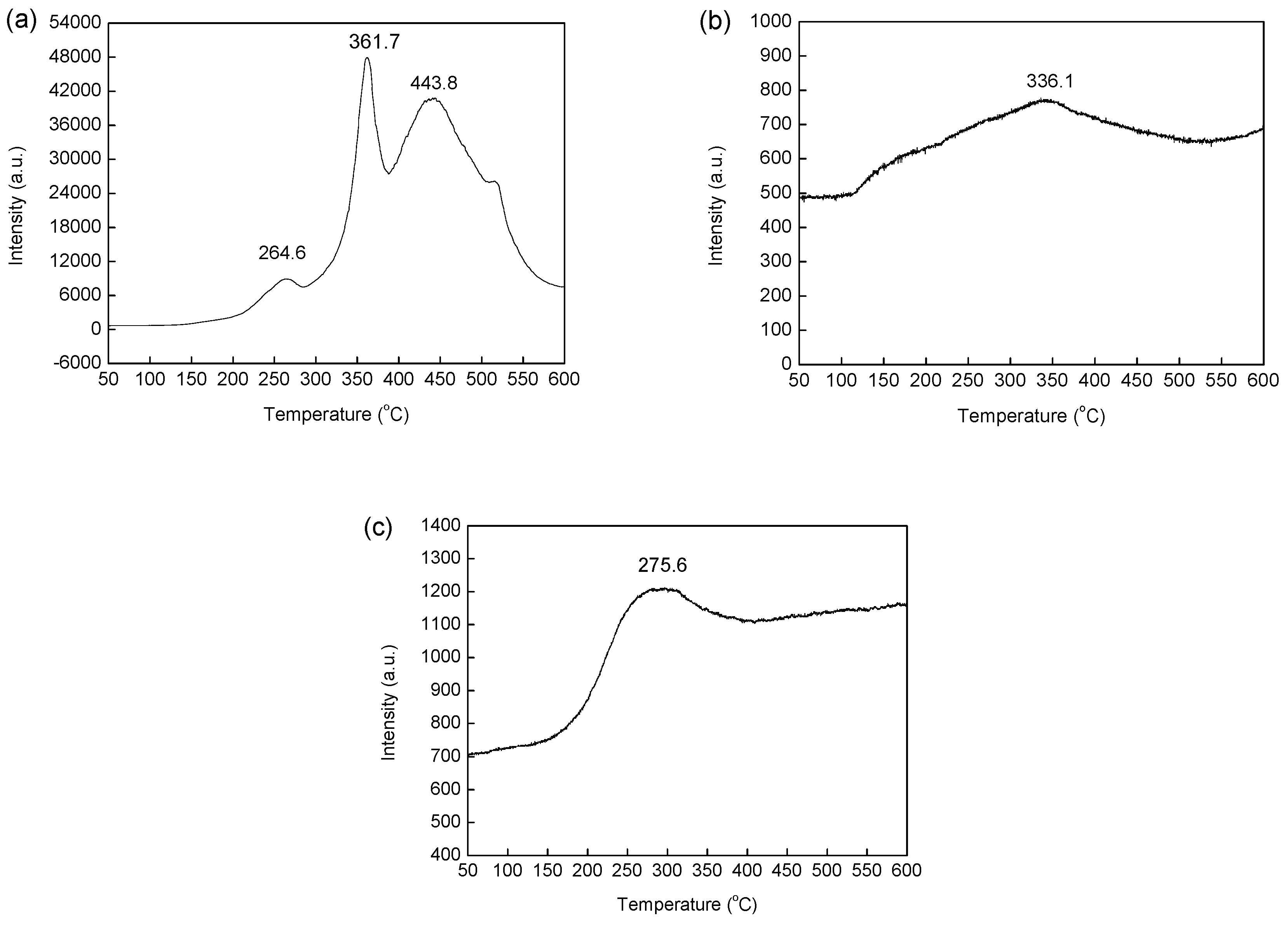
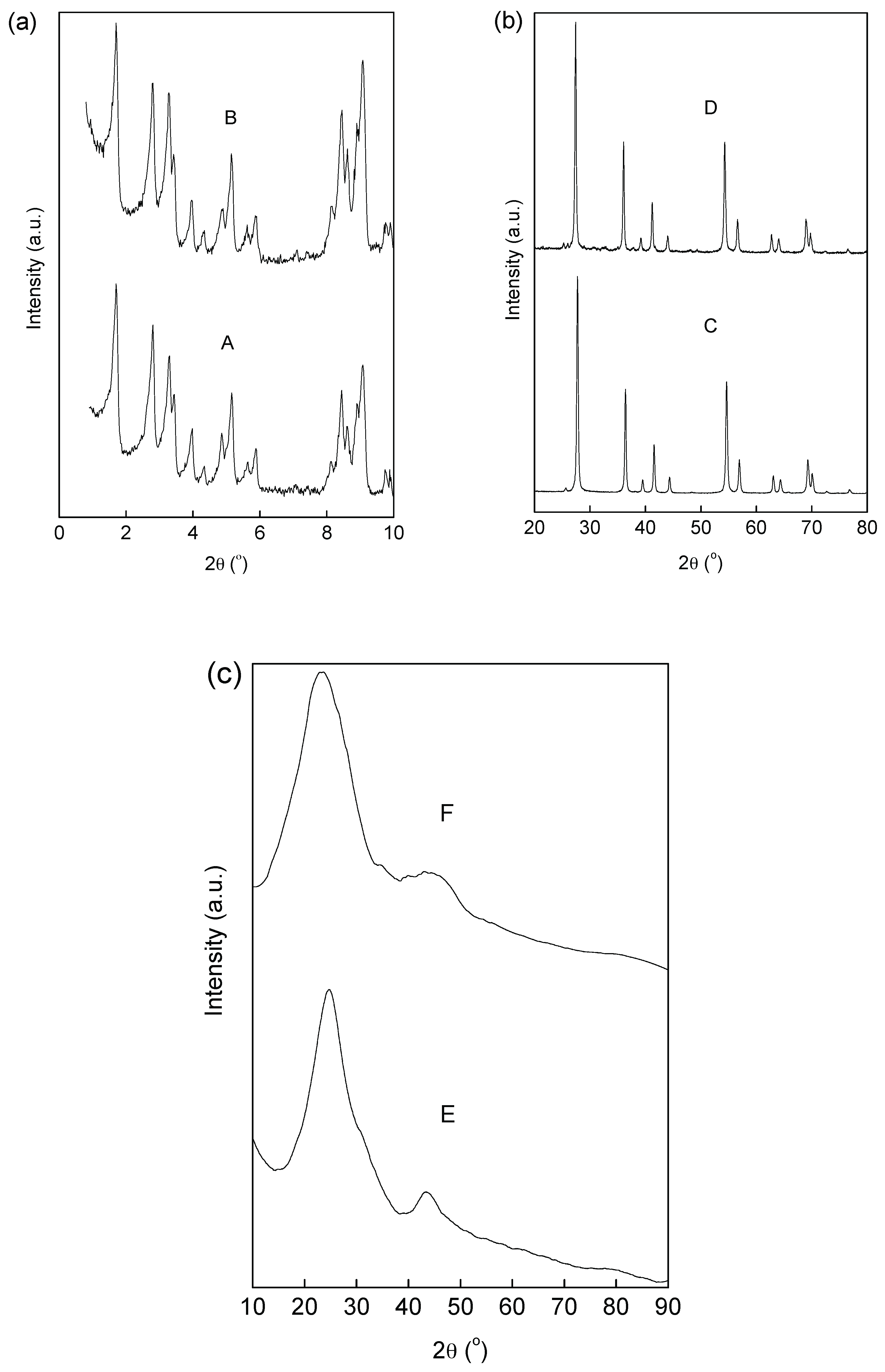

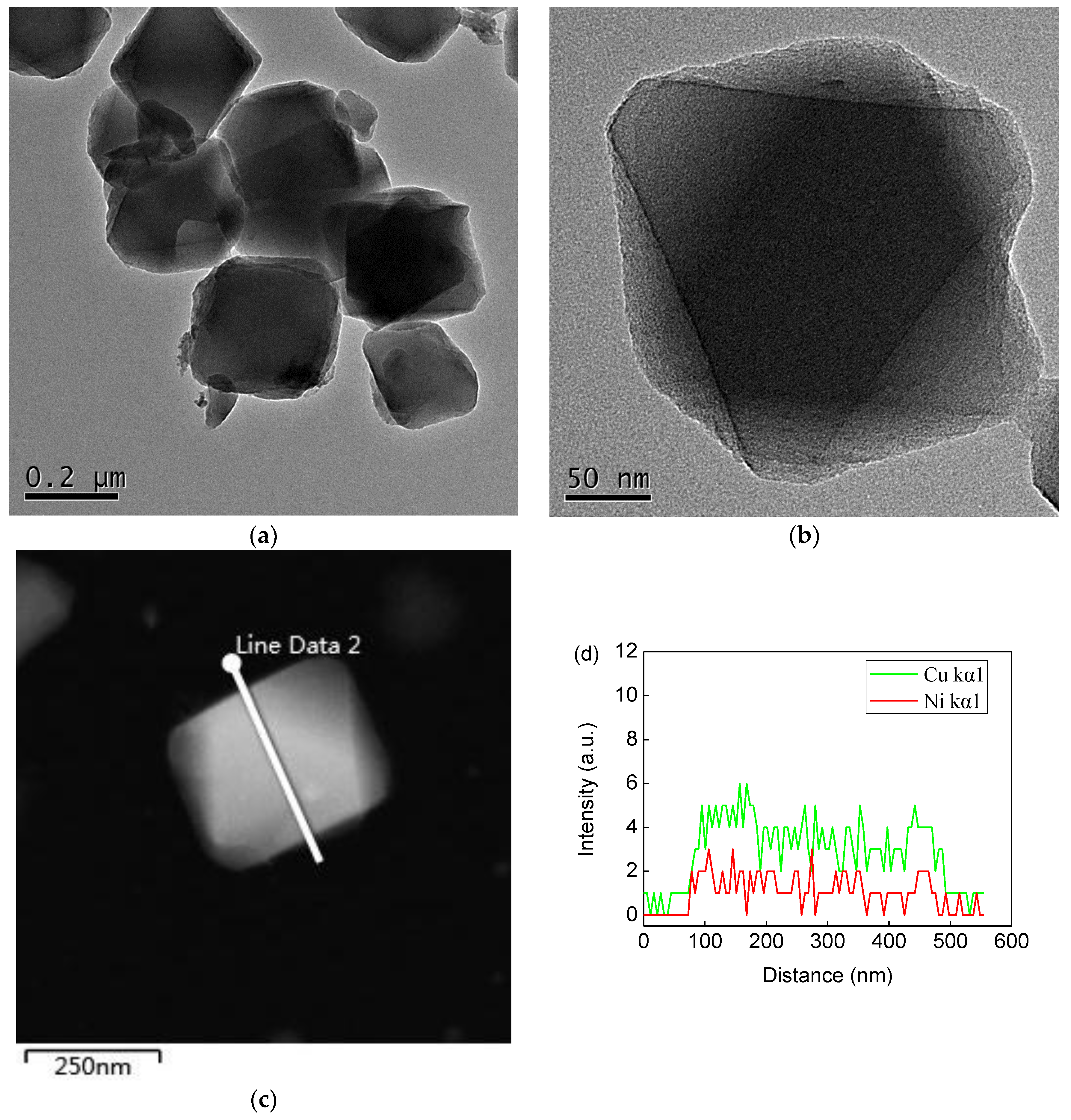
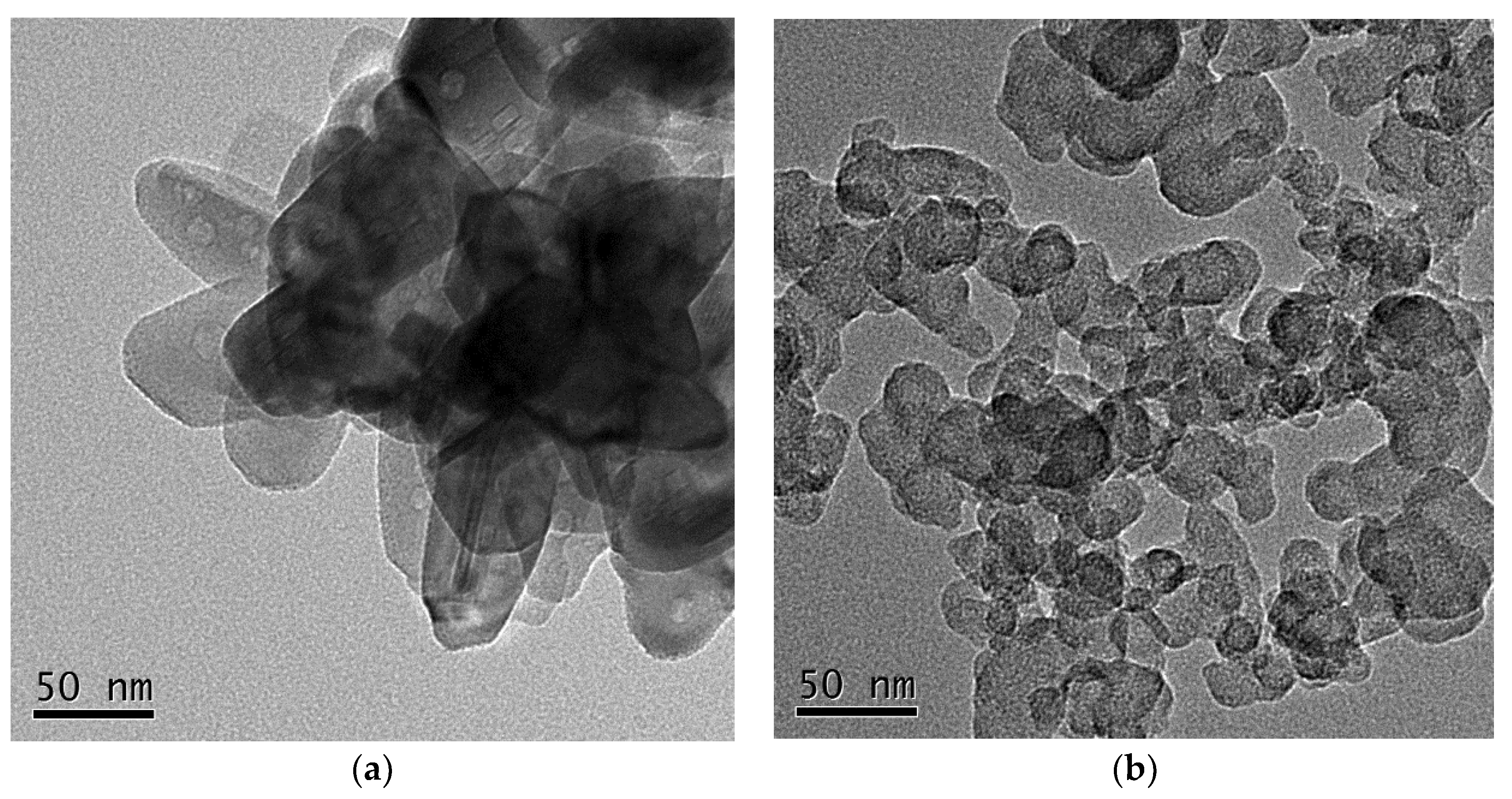
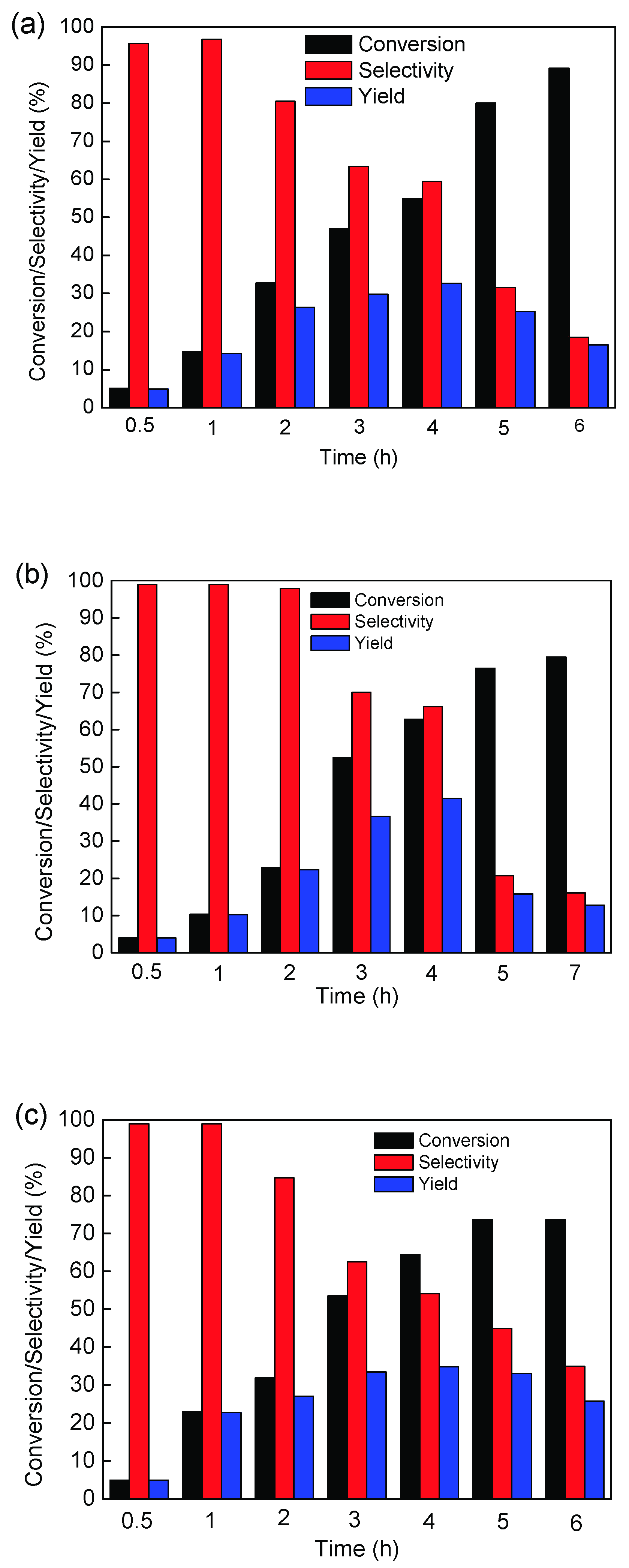
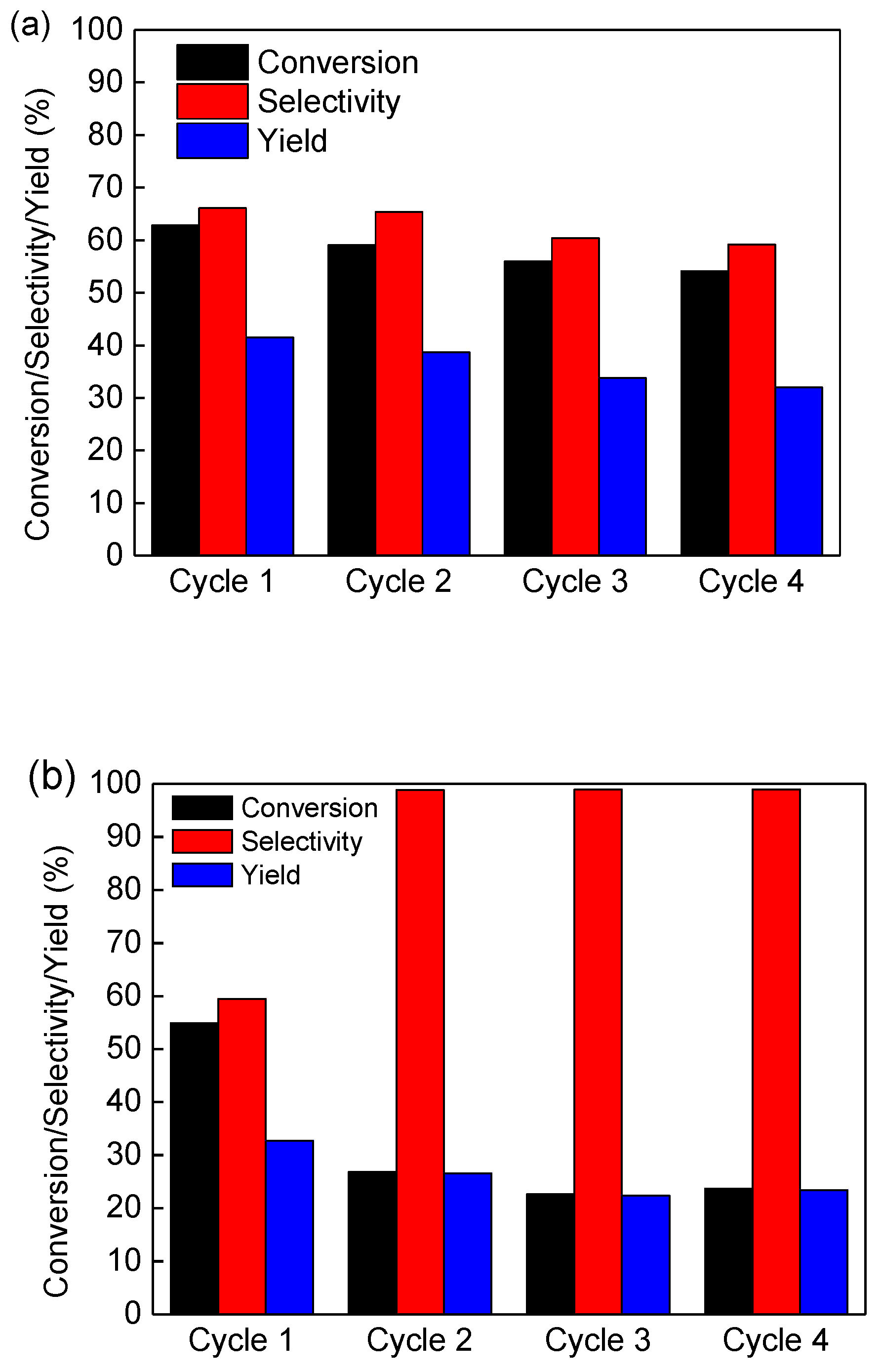
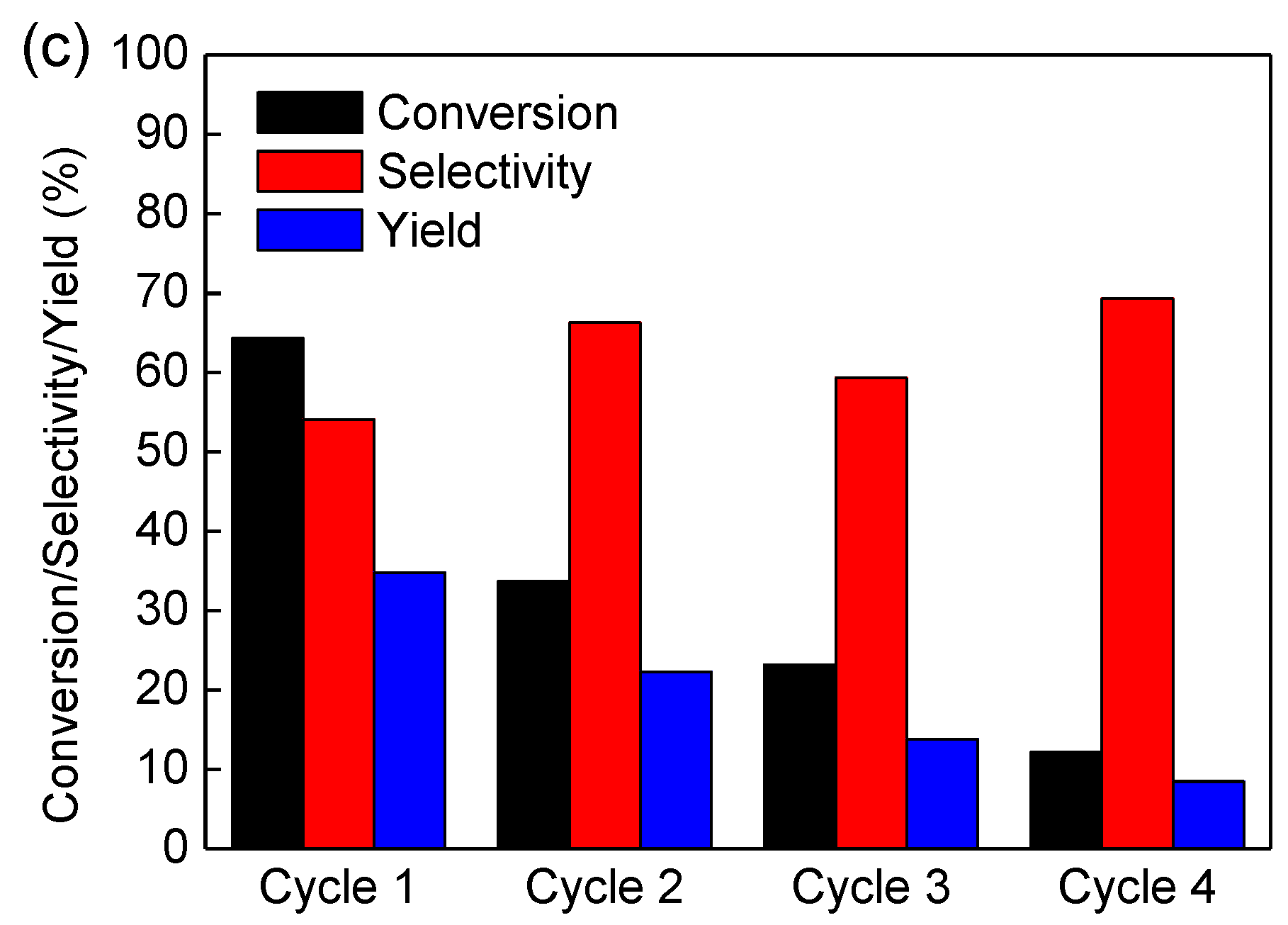
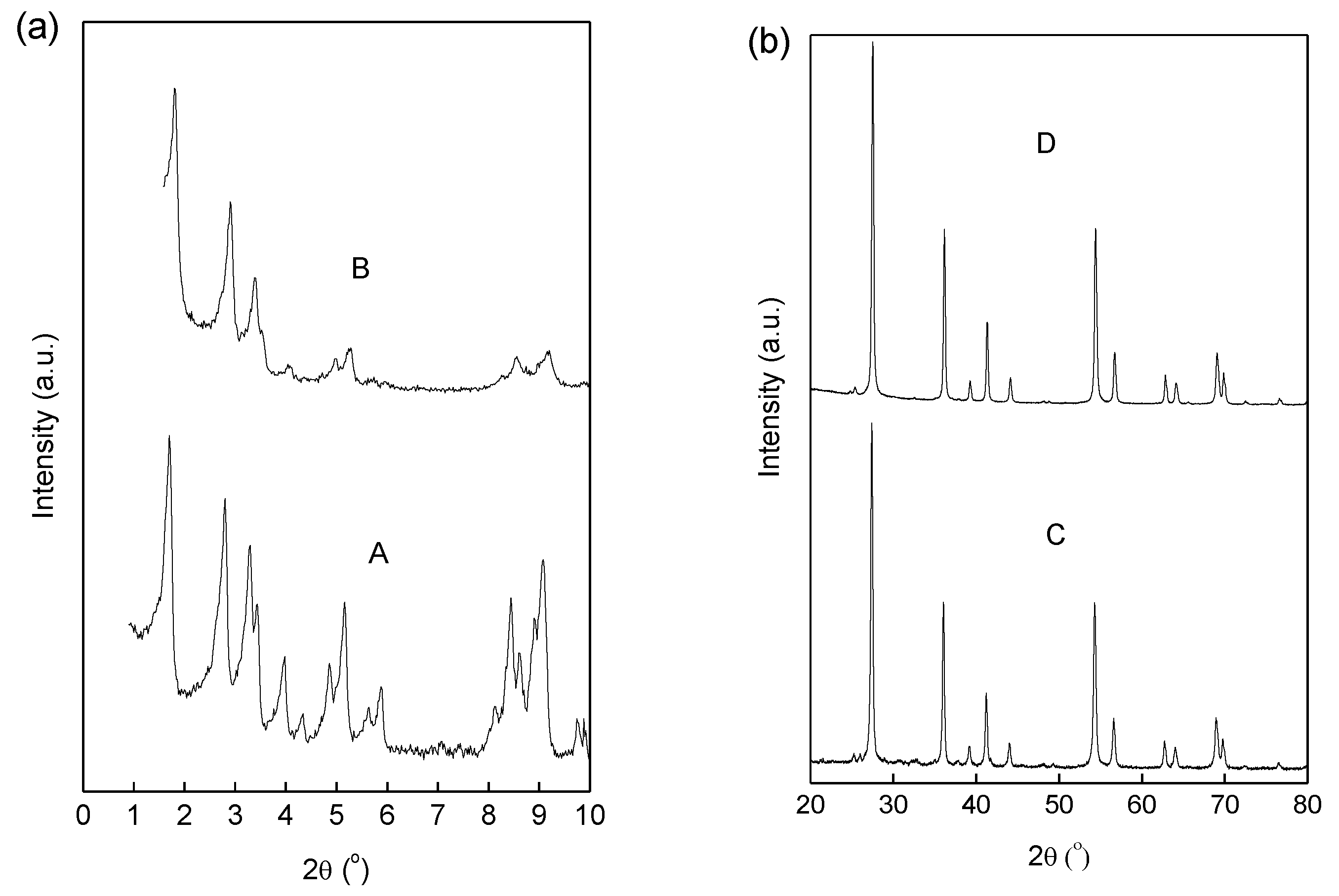

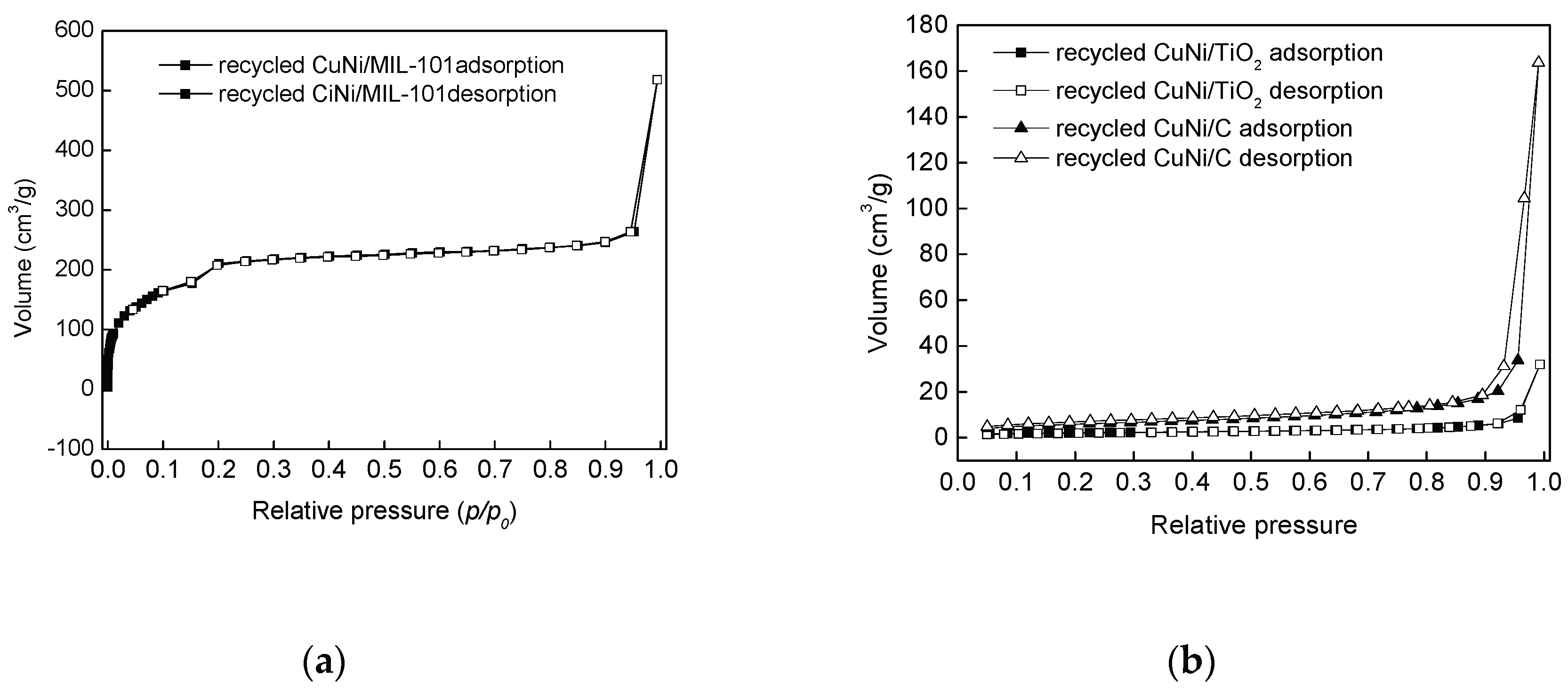
| Entry | Samples | BET Surface Area (m2/g) | Pore Volume (cm3/g) | Pore Diameter (nm) |
|---|---|---|---|---|
| 1 | MIL-101 | 1186.0 | 0.49 | 2.8 |
| 2 | CuNi/MIL-101 | 1119.2 | 0.45 | 2.5 |
| 3 | TiO2 | 15.2 | 0.014 | 4.3 |
| 4 | CuNi/TiO2 | 8.5 | 0.0078 | 4.7 |
| 5 | C | 94.9 | 0.11 | 4.6 |
| 6 | CuNi/C | 55.6 | 0.079 | 5.2 |
| Entry | Catalyst | Solvent | T (°C) | Pressure (bar) | Con. (%) 2 | Sel. (%) 2 | Yield (%) |
|---|---|---|---|---|---|---|---|
| 1 | MIL-101 | THF | 100 | 5 | 25.8 | 94.2 | 24.3 |
| 2 | TiO2 | THF | 100 | 5 | 13.6 | 83.3 | 11.3 |
| 3 | C | THF | 100 | 5 | 12.9 | 98.0 | 12.6 |
| 4 | CuNi/TiO2 | dioxane | 100 | 5 | 4.6 | 98.4 | 4.5 |
| 5 | CuNi/TiO2 | DMF | 100 | 5 | 2.9 | 98.1 | 2.8 |
| 6 | CuNi/TiO2 | acetonitrile | 100 | 5 | 3.7 | 98.3 | 3.6 |
| 7 | CuNi/TiO2 | THF | 100 | 5 | 54.9 | 59.5 | 32.7 |
| 8 | CuNi/TiO2 | THF | 80 | 5 | 5.0 | 99.0 | 5.0 |
| 9 | CuNi/TiO2 | THF | 120 | 5 | 86.2 | 15.3 | 13.2 |
| 10 | CuNi/TiO2 | THF | 100 | 1 | 42.8 | 73.7 | 31.5 |
| 11 | CuNi/TiO2 | THF | 100 | 3 | 47.5 | 63.9 | 30.4 |
| 12 | CuNi/TiO2 | THF | 100 | 7 | 78.1 | 20.9 | 16.3 |
| 13 | CuNi/MIL-101 | dioxane | 100 | 3 | 24.6 | 95.0 | 23.4 |
| 14 | CuNi/MIL-101 | DMF | 100 | 3 | 2.0 | 99.0 | 2.0 |
| 15 | CuNi/MIL-101 | acetonitrile | 100 | 3 | 10.1 | 98.2 | 9.9 |
| 16 | CuNi/MIL-101 | THF | 100 | 3 | 55.4 | 84.8 | 47.0 |
| 17 | CuNi/MIL-101 | THF | 80 | 3 | 42.0 | 98.0 | 41.2 |
| 18 | CuNi/MIL-101 | THF | 120 | 3 | 69.3 | 64.8 | 44.9 |
| 19 | CuNi/MIL-101 | THF | 100 | 1 | 34.1 | 99.0 | 33.8 |
| 20 | CuNi/MIL-101 | THF | 100 | 5 | 62.8 | 66.1 | 41.5 |
| 21 | CuNi/MIL-101 | THF | 100 | 7 | 68.6 | 43.7 | 33.4 |
| 22 | CuNi/C | dioxane | 100 | 5 | 30.9 | 94.3 | 29.1 |
| 23 | CuNi/C | DMF | 100 | 5 | 6.8 | 97.4 | 6.6 |
| 24 | CuNi/C | acetonitrile | 100 | 5 | 28.4 | 95.3 | 27.1 |
| 25 | CuNi/C | THF | 100 | 5 | 64.3 | 54.1 | 34.8 |
| 26 | CuNi/C | THF | 80 | 3 | 34.5 | 88.4 | 30.5 |
| 27 | CuNi/C | THF | 100 | 3 | 57.6 | 68.5 | 39.5 |
| 28 | CuNi/C | THF | 120 | 3 | 63.5 | 45.2 | 28.7 |
| 29 | CuNi/C | THF | 100 | 1 | 27.4 | 98.0 | 26.9 |
| 30 | CuNi/C | THF | 100 | 7 | 64.4 | 43.5 | 28.0 |
| Entry | Substrates | Products | Conv. (%) | S (%) |
|---|---|---|---|---|
| 1 |  |  | 73.8 | 24.4 |
| 2 |  |  | 87.9 | 28.3 |
| 3 |  |  | 87.3 | 25.2 |
| 4 |  |  | 74.9 | 26.2 |
| Entry | Catalyst | wCu (%) | wNi (%) | Cu:Ni Mole Ratio | Conv. (%) | S (%) | Yield (%) |
|---|---|---|---|---|---|---|---|
| 1 | Cu(3)Ni/MIL-101 | 4.45 | 1.43 | 3:1 | 77.6 | 43.3 | 33.6 |
| 2 | Cu(2)Ni/MIL-101 | 3.96 | 1.87 | 2:1 | 65.4 | 65.1 | 42.6 |
| 3 | CuNi/MIL-101 | 3.15 | 2.80 | 1:1 | 55.4 | 84.8 | 47.0 |
| 4 | CuNi(2)/MIL-101 | 2.20 | 3.77 | 1:2 | 72.6 | 49.6 | 36.0 |
| 5 | CuNi(3)/MIL-101 | 1.62 | 4.40 | 1:3 | 78.2 | 38.8 | 30.3 |
© 2019 by the authors. Licensee MDPI, Basel, Switzerland. This article is an open access article distributed under the terms and conditions of the Creative Commons Attribution (CC BY) license (http://creativecommons.org/licenses/by/4.0/).
Share and Cite
Liu, L.; Zhou, X.; Liu, L.; Jiang, S.; Li, Y.; Guo, L.; Yan, S.; Tai, X. Heterogeneous Bimetallic Cu–Ni Nanoparticle-Supported Catalysts in the Selective Oxidation of Benzyl Alcohol to Benzaldehyde. Catalysts 2019, 9, 538. https://doi.org/10.3390/catal9060538
Liu L, Zhou X, Liu L, Jiang S, Li Y, Guo L, Yan S, Tai X. Heterogeneous Bimetallic Cu–Ni Nanoparticle-Supported Catalysts in the Selective Oxidation of Benzyl Alcohol to Benzaldehyde. Catalysts. 2019; 9(6):538. https://doi.org/10.3390/catal9060538
Chicago/Turabian StyleLiu, Lili, Xiaojing Zhou, Li Liu, Shuai Jiang, Yingjie Li, Luxia Guo, Shijuan Yan, and Xishi Tai. 2019. "Heterogeneous Bimetallic Cu–Ni Nanoparticle-Supported Catalysts in the Selective Oxidation of Benzyl Alcohol to Benzaldehyde" Catalysts 9, no. 6: 538. https://doi.org/10.3390/catal9060538
APA StyleLiu, L., Zhou, X., Liu, L., Jiang, S., Li, Y., Guo, L., Yan, S., & Tai, X. (2019). Heterogeneous Bimetallic Cu–Ni Nanoparticle-Supported Catalysts in the Selective Oxidation of Benzyl Alcohol to Benzaldehyde. Catalysts, 9(6), 538. https://doi.org/10.3390/catal9060538





